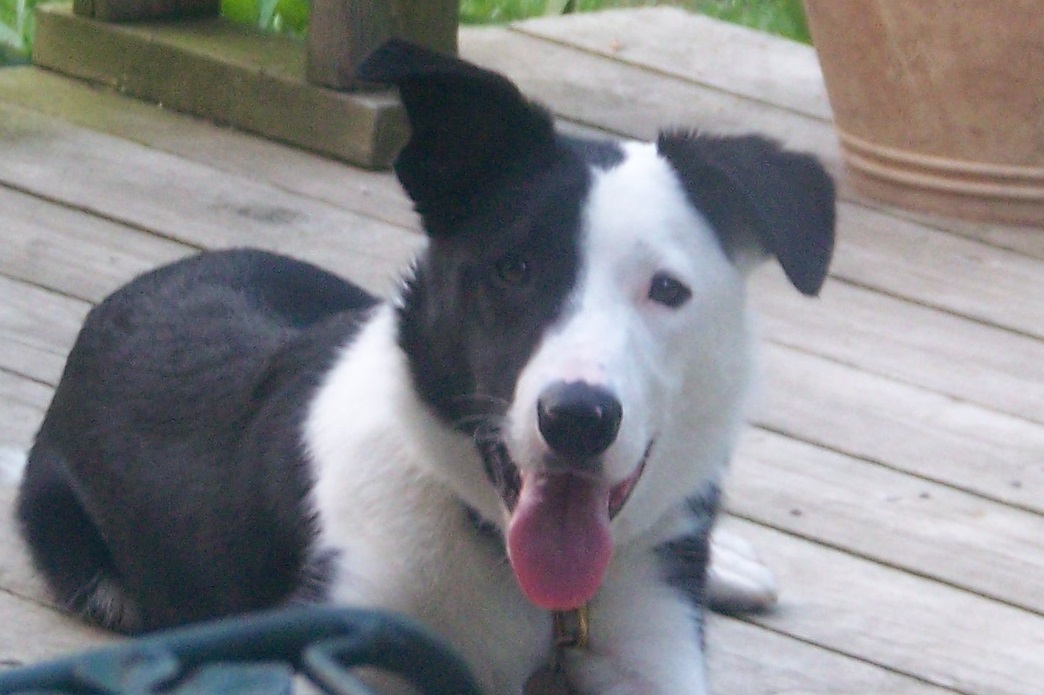The art of sleeping
This might seem like a strange topic in a blog about raising a border collie puppy. After all, I’ve had BC owners seriously tell me they have NEVER seen their BCs sleep. I interpret that to mean the dogs are sleeping lightly or maybe with one eye open. They must actually sleep, right? Tai rests well in his crate but when I’m in the room, he is watching me. There are infrequent occasions when I catch him deeply sleeping – usually in a position similar to this photo.  From one who positively marvels at the asanas obtained by my yoga instructors…I not only admire, but envy his flexibility. When out of his crate, it’s comment worthy when he stops moving long enough to lay down and the prospect of this 6 month old puppy making the decision out of his crate to spend his time catching a few zzzz’s seems unlikely. So, will he develop an “off switch” as an adult dog? I think so and here’s why.
From one who positively marvels at the asanas obtained by my yoga instructors…I not only admire, but envy his flexibility. When out of his crate, it’s comment worthy when he stops moving long enough to lay down and the prospect of this 6 month old puppy making the decision out of his crate to spend his time catching a few zzzz’s seems unlikely. So, will he develop an “off switch” as an adult dog? I think so and here’s why.
My adult shelties are active, engaging, smart little guys who are always ready for action and… they are masters of sleeping. Anytime, anywhere. When there is nothing else especially interesting to do, they lay down and seem to enter a place of complete peace. Untroubled, relaxed, resting. Modern humans, on the other hand, need to sleep for sound mental health but sometimes – or maybe even often – struggle with good sleep or enough sleep. Being one of those modern humans, I admire my dog’s ability to sleep.
I’m reading the book “Cold” by biologist Bill Streever, “Adventures in the World’s Frozen Places”. Based on their journals, he chronicles early polar explorers and writes “when one reads past the stoicism and heroics, the history of polar exploration becomes one long accident report mixed with one long obituary.” Yep. Many of the explorers kept journals and many of them didn’t survive. There were exceptions and sleeping was a big part of the success. Fridtjof Nansen was a Norwegian explorer who after reaching within 4 degrees of the North pole, turned south and overwintered by digging a hole in the permafrost and building a hut out of stone and bear furs. Key to he and his companion’s survival (they even gained weight over the winter) was sleep…to a point approaching hibernation. Nansen wrote “We carried this art to a high pitch of perfection, and could sometimes put in as much as 20 hours’ sleep in the 24”.
Mammals burn fewer calories when they sleep. This is probably why dogs are so good at sleeping. Wolves are good sleepers too. Winter observers on Isle Royale estimate wolves sleep 30% of the time. And that doesn’t count what goes on at night. Wolves, like many predators, live a feast or famine lifestyle. When they are hunting they burn a tremendous number of calories and since food is not predictable, it is best to rest and preserve calories when they get a chance. As Wolf biologist John A. Vucetich writes “When food is plentiful, wolves spend a substantial amount of time simply resting, because they can. When food is scarce, wolves spend much time resting because they need to.”
So, that “off switch” that we dog owners talk about, is actually an evolutionary survival mechanism. If like the wolves on Isle Royale, puppy Tai was walking 10 or more miles a day with a wolf pack instead of 3 or 4 miles with his human led pack, I bet even at this age he would enter a state of restful, eyes closed, slower respiration sleep when he had the chance. The voluntary “off switch” will come along with adulthood. I’ve got thousands of years of evolution to back me up.

Tai’s father and Uncle Ben are almost 6 and have never taken a nap outside of a crate. Tai’s grandmother, Babe, died at age 11 without a voluntary rest. Great Aunt, Gyp, is now 10 and will take a snooze after a very long day of work when there is absolutely nothing going on – I’ve seen it twice. Meg, at age 15, will nap.
LOL. Ok…I won’t hold my breath for Tai to start napping!
Along with the evolutionary “napping” mechanism, I would think that you would have to consider the breed specific hard wiring. I would guess that BCs in general, and Tai in particular, have evolutionary hard wiring to “sleep with one eye open” and may have adapted their rest periods to accommodate and allow for the need to always be on the look out while “working”.
My shih tzus, on the other hand, have perfected the art of napping almost to the point of ridiculousness. They could probably survive in the polar regions with Nansen without any problem. 🙂